ECON1165: Exploring International Economics and Innovation Concepts
VerifiedAdded on 2023/01/09
|10
|2625
|57
Report
AI Summary
This report provides a detailed analysis of key concepts in international economics and innovation. It begins by differentiating between innovation and invention, then explores various types of innovation, including product, process, and business model innovation. The report examines the relationship between technological and social capabilities, and their impact on economic development. It ranks factors influencing economic development, highlighting the importance of favorable business regulations. The role of Multinational Corporations (MNCs) is discussed, including their best practices and impact on organizational and technological knowledge. The report also delves into strategic alliances, motivations for forming them, and the challenges local companies face due to MNC competition. Furthermore, it explores governance structures, including market-based, modular, relational, and captive structures, and their implications for firms and economic development. The report concludes with a discussion of tax optimization strategies and the effects of transfer pricing regulations on MNCs.
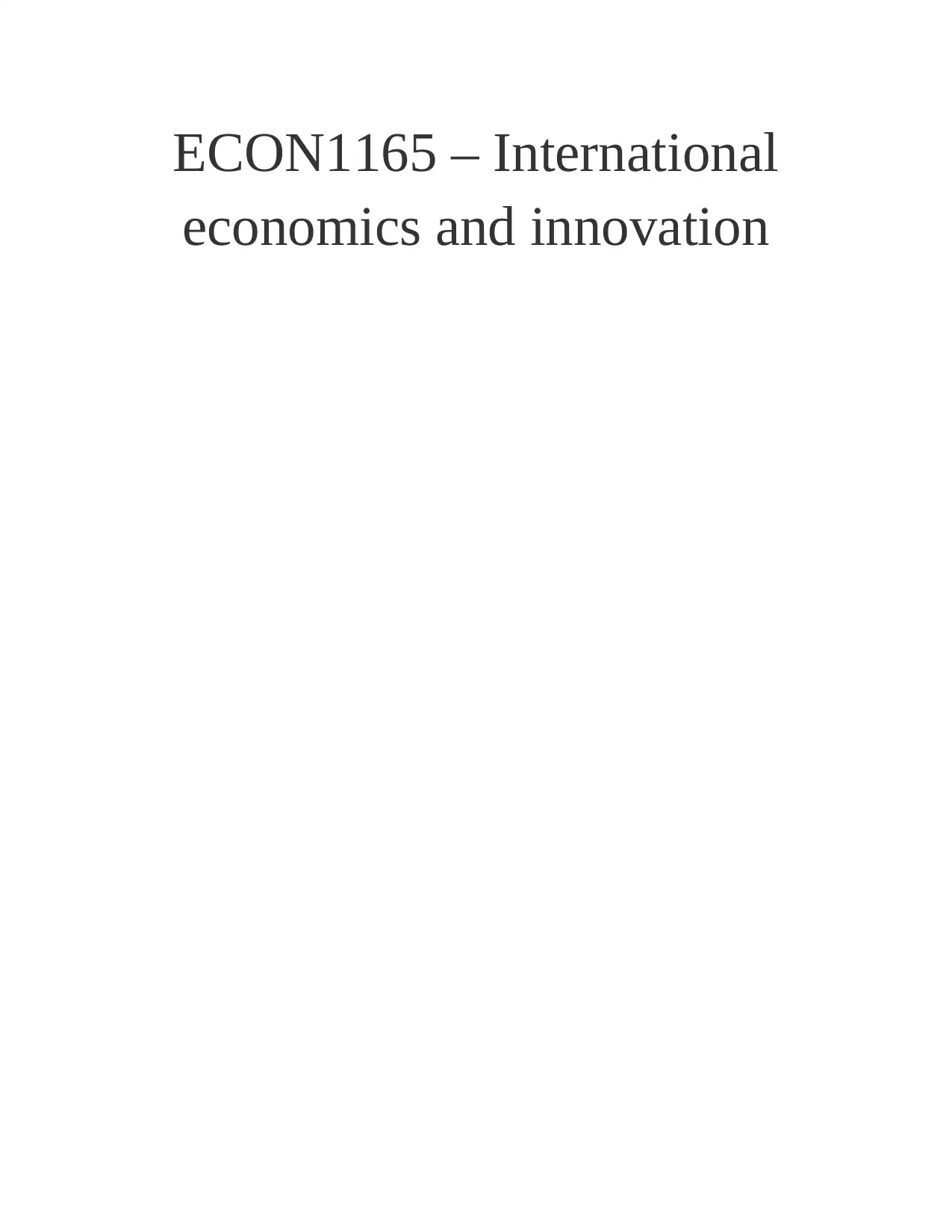
ECON1165 – International
economics and innovation
economics and innovation
Paraphrase This Document
Need a fresh take? Get an instant paraphrase of this document with our AI Paraphraser
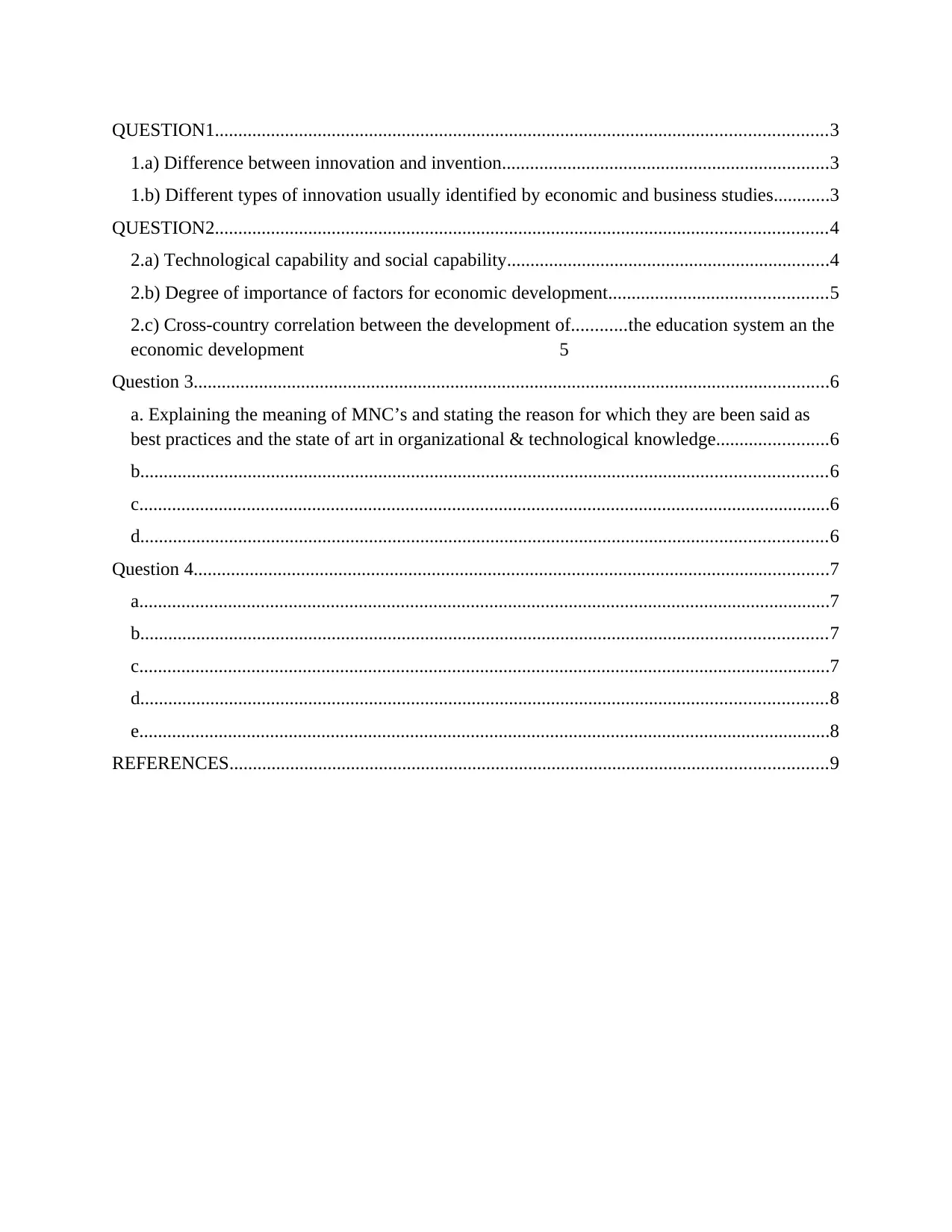
QUESTION1...................................................................................................................................3
1.a) Difference between innovation and invention......................................................................3
1.b) Different types of innovation usually identified by economic and business studies............3
QUESTION2...................................................................................................................................4
2.a) Technological capability and social capability.....................................................................4
2.b) Degree of importance of factors for economic development...............................................5
2.c) Cross-country correlation between the development of............the education system an the
economic development 5
Question 3........................................................................................................................................6
a. Explaining the meaning of MNC’s and stating the reason for which they are been said as
best practices and the state of art in organizational & technological knowledge........................6
b...................................................................................................................................................6
c....................................................................................................................................................6
d...................................................................................................................................................6
Question 4........................................................................................................................................7
a....................................................................................................................................................7
b...................................................................................................................................................7
c....................................................................................................................................................7
d...................................................................................................................................................8
e....................................................................................................................................................8
REFERENCES................................................................................................................................9
1.a) Difference between innovation and invention......................................................................3
1.b) Different types of innovation usually identified by economic and business studies............3
QUESTION2...................................................................................................................................4
2.a) Technological capability and social capability.....................................................................4
2.b) Degree of importance of factors for economic development...............................................5
2.c) Cross-country correlation between the development of............the education system an the
economic development 5
Question 3........................................................................................................................................6
a. Explaining the meaning of MNC’s and stating the reason for which they are been said as
best practices and the state of art in organizational & technological knowledge........................6
b...................................................................................................................................................6
c....................................................................................................................................................6
d...................................................................................................................................................6
Question 4........................................................................................................................................7
a....................................................................................................................................................7
b...................................................................................................................................................7
c....................................................................................................................................................7
d...................................................................................................................................................8
e....................................................................................................................................................8
REFERENCES................................................................................................................................9
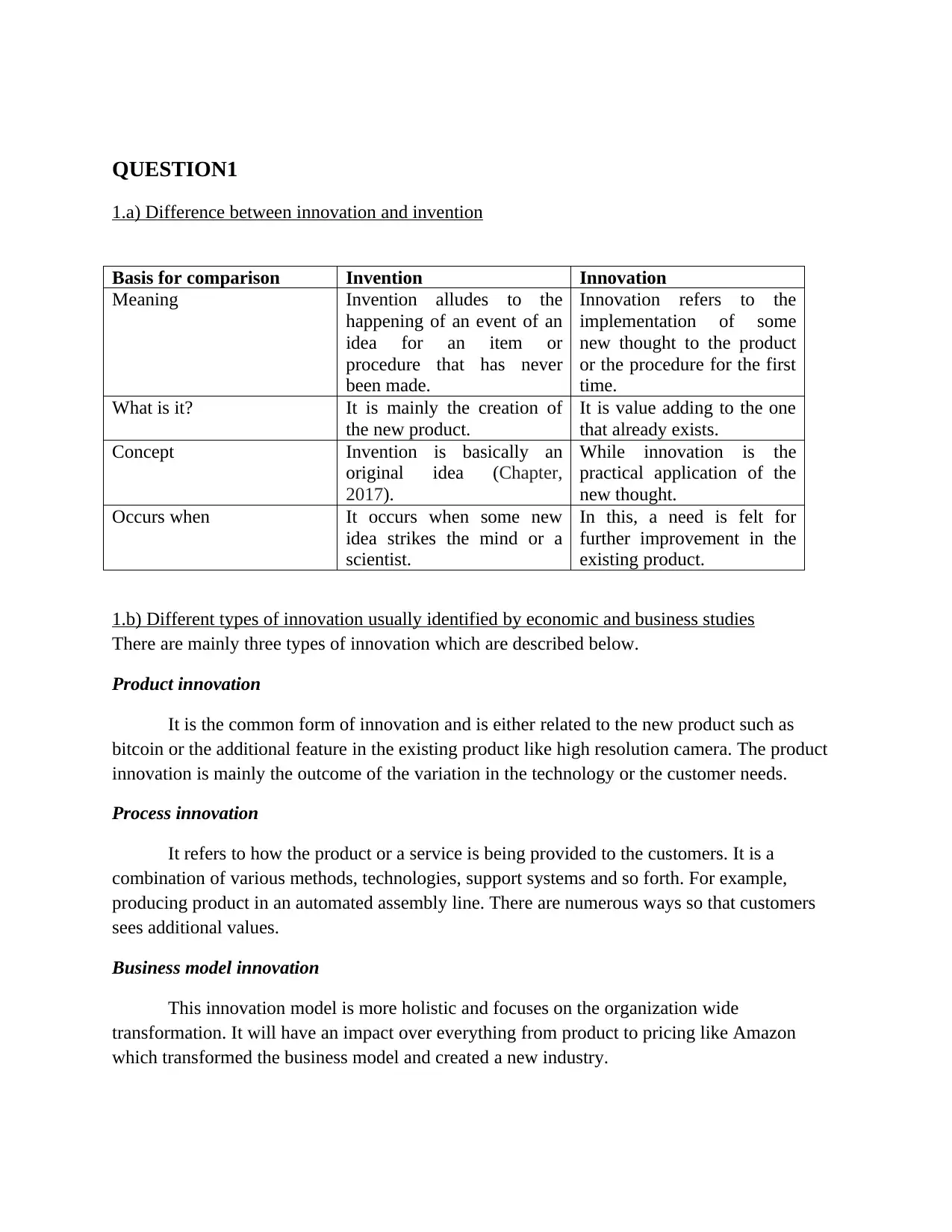
QUESTION1
1.a) Difference between innovation and invention
Basis for comparison Invention Innovation
Meaning Invention alludes to the
happening of an event of an
idea for an item or
procedure that has never
been made.
Innovation refers to the
implementation of some
new thought to the product
or the procedure for the first
time.
What is it? It is mainly the creation of
the new product.
It is value adding to the one
that already exists.
Concept Invention is basically an
original idea (Chapter,
2017).
While innovation is the
practical application of the
new thought.
Occurs when It occurs when some new
idea strikes the mind or a
scientist.
In this, a need is felt for
further improvement in the
existing product.
1.b) Different types of innovation usually identified by economic and business studies
There are mainly three types of innovation which are described below.
Product innovation
It is the common form of innovation and is either related to the new product such as
bitcoin or the additional feature in the existing product like high resolution camera. The product
innovation is mainly the outcome of the variation in the technology or the customer needs.
Process innovation
It refers to how the product or a service is being provided to the customers. It is a
combination of various methods, technologies, support systems and so forth. For example,
producing product in an automated assembly line. There are numerous ways so that customers
sees additional values.
Business model innovation
This innovation model is more holistic and focuses on the organization wide
transformation. It will have an impact over everything from product to pricing like Amazon
which transformed the business model and created a new industry.
1.a) Difference between innovation and invention
Basis for comparison Invention Innovation
Meaning Invention alludes to the
happening of an event of an
idea for an item or
procedure that has never
been made.
Innovation refers to the
implementation of some
new thought to the product
or the procedure for the first
time.
What is it? It is mainly the creation of
the new product.
It is value adding to the one
that already exists.
Concept Invention is basically an
original idea (Chapter,
2017).
While innovation is the
practical application of the
new thought.
Occurs when It occurs when some new
idea strikes the mind or a
scientist.
In this, a need is felt for
further improvement in the
existing product.
1.b) Different types of innovation usually identified by economic and business studies
There are mainly three types of innovation which are described below.
Product innovation
It is the common form of innovation and is either related to the new product such as
bitcoin or the additional feature in the existing product like high resolution camera. The product
innovation is mainly the outcome of the variation in the technology or the customer needs.
Process innovation
It refers to how the product or a service is being provided to the customers. It is a
combination of various methods, technologies, support systems and so forth. For example,
producing product in an automated assembly line. There are numerous ways so that customers
sees additional values.
Business model innovation
This innovation model is more holistic and focuses on the organization wide
transformation. It will have an impact over everything from product to pricing like Amazon
which transformed the business model and created a new industry.
⊘ This is a preview!⊘
Do you want full access?
Subscribe today to unlock all pages.

Trusted by 1+ million students worldwide
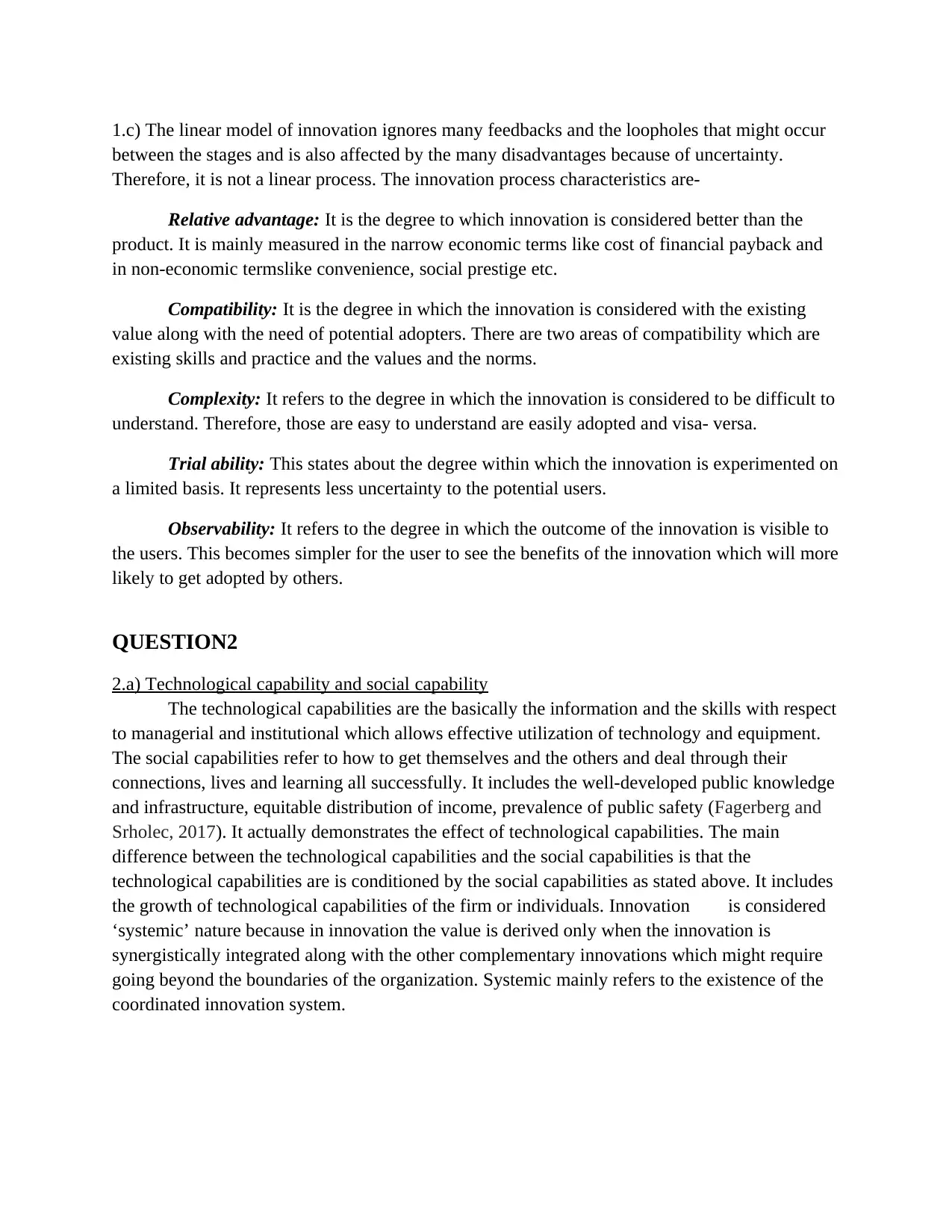
1.c) The linear model of innovation ignores many feedbacks and the loopholes that might occur
between the stages and is also affected by the many disadvantages because of uncertainty.
Therefore, it is not a linear process. The innovation process characteristics are-
Relative advantage: It is the degree to which innovation is considered better than the
product. It is mainly measured in the narrow economic terms like cost of financial payback and
in non-economic termslike convenience, social prestige etc.
Compatibility: It is the degree in which the innovation is considered with the existing
value along with the need of potential adopters. There are two areas of compatibility which are
existing skills and practice and the values and the norms.
Complexity: It refers to the degree in which the innovation is considered to be difficult to
understand. Therefore, those are easy to understand are easily adopted and visa- versa.
Trial ability: This states about the degree within which the innovation is experimented on
a limited basis. It represents less uncertainty to the potential users.
Observability: It refers to the degree in which the outcome of the innovation is visible to
the users. This becomes simpler for the user to see the benefits of the innovation which will more
likely to get adopted by others.
QUESTION2
2.a) Technological capability and social capability
The technological capabilities are the basically the information and the skills with respect
to managerial and institutional which allows effective utilization of technology and equipment.
The social capabilities refer to how to get themselves and the others and deal through their
connections, lives and learning all successfully. It includes the well-developed public knowledge
and infrastructure, equitable distribution of income, prevalence of public safety (Fagerberg and
Srholec, 2017). It actually demonstrates the effect of technological capabilities. The main
difference between the technological capabilities and the social capabilities is that the
technological capabilities are is conditioned by the social capabilities as stated above. It includes
the growth of technological capabilities of the firm or individuals. Innovation is considered
‘systemic’ nature because in innovation the value is derived only when the innovation is
synergistically integrated along with the other complementary innovations which might require
going beyond the boundaries of the organization. Systemic mainly refers to the existence of the
coordinated innovation system.
between the stages and is also affected by the many disadvantages because of uncertainty.
Therefore, it is not a linear process. The innovation process characteristics are-
Relative advantage: It is the degree to which innovation is considered better than the
product. It is mainly measured in the narrow economic terms like cost of financial payback and
in non-economic termslike convenience, social prestige etc.
Compatibility: It is the degree in which the innovation is considered with the existing
value along with the need of potential adopters. There are two areas of compatibility which are
existing skills and practice and the values and the norms.
Complexity: It refers to the degree in which the innovation is considered to be difficult to
understand. Therefore, those are easy to understand are easily adopted and visa- versa.
Trial ability: This states about the degree within which the innovation is experimented on
a limited basis. It represents less uncertainty to the potential users.
Observability: It refers to the degree in which the outcome of the innovation is visible to
the users. This becomes simpler for the user to see the benefits of the innovation which will more
likely to get adopted by others.
QUESTION2
2.a) Technological capability and social capability
The technological capabilities are the basically the information and the skills with respect
to managerial and institutional which allows effective utilization of technology and equipment.
The social capabilities refer to how to get themselves and the others and deal through their
connections, lives and learning all successfully. It includes the well-developed public knowledge
and infrastructure, equitable distribution of income, prevalence of public safety (Fagerberg and
Srholec, 2017). It actually demonstrates the effect of technological capabilities. The main
difference between the technological capabilities and the social capabilities is that the
technological capabilities are is conditioned by the social capabilities as stated above. It includes
the growth of technological capabilities of the firm or individuals. Innovation is considered
‘systemic’ nature because in innovation the value is derived only when the innovation is
synergistically integrated along with the other complementary innovations which might require
going beyond the boundaries of the organization. Systemic mainly refers to the existence of the
coordinated innovation system.
Paraphrase This Document
Need a fresh take? Get an instant paraphrase of this document with our AI Paraphraser
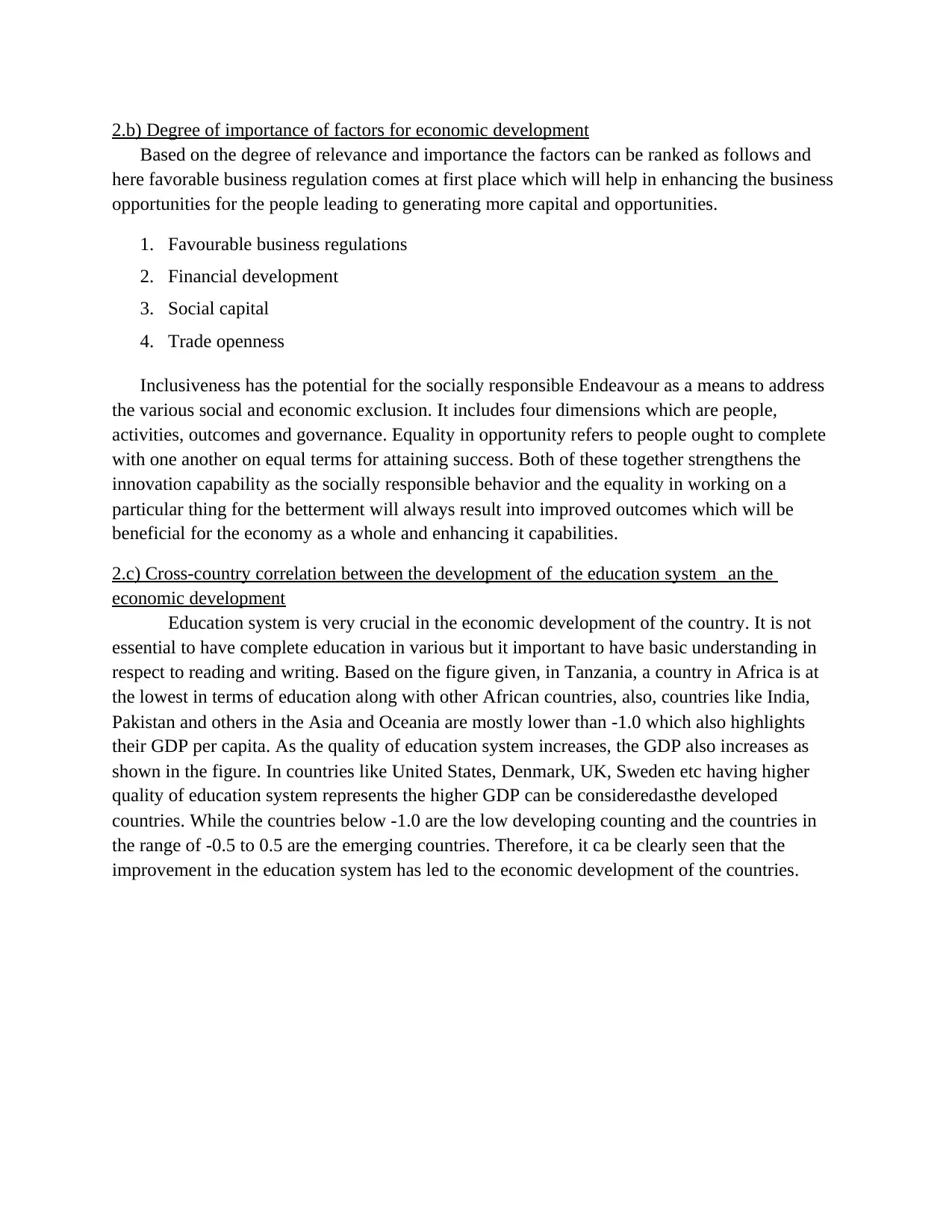
2.b) Degree of importance of factors for economic development
Based on the degree of relevance and importance the factors can be ranked as follows and
here favorable business regulation comes at first place which will help in enhancing the business
opportunities for the people leading to generating more capital and opportunities.
1. Favourable business regulations
2. Financial development
3. Social capital
4. Trade openness
Inclusiveness has the potential for the socially responsible Endeavour as a means to address
the various social and economic exclusion. It includes four dimensions which are people,
activities, outcomes and governance. Equality in opportunity refers to people ought to complete
with one another on equal terms for attaining success. Both of these together strengthens the
innovation capability as the socially responsible behavior and the equality in working on a
particular thing for the betterment will always result into improved outcomes which will be
beneficial for the economy as a whole and enhancing it capabilities.
2.c) Cross-country correlation between the development of the education system an the
economic development
Education system is very crucial in the economic development of the country. It is not
essential to have complete education in various but it important to have basic understanding in
respect to reading and writing. Based on the figure given, in Tanzania, a country in Africa is at
the lowest in terms of education along with other African countries, also, countries like India,
Pakistan and others in the Asia and Oceania are mostly lower than -1.0 which also highlights
their GDP per capita. As the quality of education system increases, the GDP also increases as
shown in the figure. In countries like United States, Denmark, UK, Sweden etc having higher
quality of education system represents the higher GDP can be consideredasthe developed
countries. While the countries below -1.0 are the low developing counting and the countries in
the range of -0.5 to 0.5 are the emerging countries. Therefore, it ca be clearly seen that the
improvement in the education system has led to the economic development of the countries.
Based on the degree of relevance and importance the factors can be ranked as follows and
here favorable business regulation comes at first place which will help in enhancing the business
opportunities for the people leading to generating more capital and opportunities.
1. Favourable business regulations
2. Financial development
3. Social capital
4. Trade openness
Inclusiveness has the potential for the socially responsible Endeavour as a means to address
the various social and economic exclusion. It includes four dimensions which are people,
activities, outcomes and governance. Equality in opportunity refers to people ought to complete
with one another on equal terms for attaining success. Both of these together strengthens the
innovation capability as the socially responsible behavior and the equality in working on a
particular thing for the betterment will always result into improved outcomes which will be
beneficial for the economy as a whole and enhancing it capabilities.
2.c) Cross-country correlation between the development of the education system an the
economic development
Education system is very crucial in the economic development of the country. It is not
essential to have complete education in various but it important to have basic understanding in
respect to reading and writing. Based on the figure given, in Tanzania, a country in Africa is at
the lowest in terms of education along with other African countries, also, countries like India,
Pakistan and others in the Asia and Oceania are mostly lower than -1.0 which also highlights
their GDP per capita. As the quality of education system increases, the GDP also increases as
shown in the figure. In countries like United States, Denmark, UK, Sweden etc having higher
quality of education system represents the higher GDP can be consideredasthe developed
countries. While the countries below -1.0 are the low developing counting and the countries in
the range of -0.5 to 0.5 are the emerging countries. Therefore, it ca be clearly seen that the
improvement in the education system has led to the economic development of the countries.

Question 3
a. Explaining the meaning of MNC’s and stating the reason for which they are been said as best
practices and the state of art in organizational & technological knowledge
MNC means the company that has facilities and the assets in more than 1 country apart
from its home nation. Such companies are having offices or the factories within different
countries & centralized global management. This type of company participate in the business
within more than two countries and could have positive value of economic effect on country
where business is been taking place. An MNC s been characterized by the geographically
dispersed units where subsidiaries and the headquarters are been located in different type of
countries (Cohen, 2018). Every unit operates in particular context of host country and
communicates with the local network of business such as suppliers or the buyers in legal &
economic framework of country that influences features of MNCs. They are been indicated as
best practices as they overcome cultural & geographical distances and is required to adopt host
country environment by establishing wholly-owned unit through an acquisition of an existing
company by way of forming the joint venture with partner in local market.
b.
The four major motivations or benefits that I would be enjoying by forming the strategic
alliances that includes growth strategies of the parent firms for entering into the new market,
procurement of the new technology or the cheapest and best quality products at lower cost,
mitigation of the financial risks and maintaining competitive edge for the firms. In today’s
dynamic world, role of the strategic alliance is becoming as more critical to performance of
MNC (Ferraris, Santoro and Scuotto, 2018). It brings about new cooperation opportunities for
the two organizations at different successive stage of production process.
c.
As the protectionist barrier crumble in the emerging markets across the world, MNC are
been rushing in new kind of opportunities for the growth. For the local companies, arrival of
MNC in the market causes intense competition and shut down of the market (Monteiro and
Birkinshaw, 2017). In order to overcome the competition, I would be calling on government for
reinstating the trade barriers or in providing some other kind of support through becoming
subordinate partner to the MNC or by simply selling out the product at low cost than the MNC so
that I could be able to attract large customers to purchase my products.
d.
Tax authorities restricting the transfer pricing increasingly for limiting tax minimum
behavior of the multinational corporations, so as a policy advisor I would be introducing tax-
optimizing & tax legislations on group level in entailing the far-reaching implications for
controlling management of MNC. Moreover, restricted accountability might limit motivation for
a. Explaining the meaning of MNC’s and stating the reason for which they are been said as best
practices and the state of art in organizational & technological knowledge
MNC means the company that has facilities and the assets in more than 1 country apart
from its home nation. Such companies are having offices or the factories within different
countries & centralized global management. This type of company participate in the business
within more than two countries and could have positive value of economic effect on country
where business is been taking place. An MNC s been characterized by the geographically
dispersed units where subsidiaries and the headquarters are been located in different type of
countries (Cohen, 2018). Every unit operates in particular context of host country and
communicates with the local network of business such as suppliers or the buyers in legal &
economic framework of country that influences features of MNCs. They are been indicated as
best practices as they overcome cultural & geographical distances and is required to adopt host
country environment by establishing wholly-owned unit through an acquisition of an existing
company by way of forming the joint venture with partner in local market.
b.
The four major motivations or benefits that I would be enjoying by forming the strategic
alliances that includes growth strategies of the parent firms for entering into the new market,
procurement of the new technology or the cheapest and best quality products at lower cost,
mitigation of the financial risks and maintaining competitive edge for the firms. In today’s
dynamic world, role of the strategic alliance is becoming as more critical to performance of
MNC (Ferraris, Santoro and Scuotto, 2018). It brings about new cooperation opportunities for
the two organizations at different successive stage of production process.
c.
As the protectionist barrier crumble in the emerging markets across the world, MNC are
been rushing in new kind of opportunities for the growth. For the local companies, arrival of
MNC in the market causes intense competition and shut down of the market (Monteiro and
Birkinshaw, 2017). In order to overcome the competition, I would be calling on government for
reinstating the trade barriers or in providing some other kind of support through becoming
subordinate partner to the MNC or by simply selling out the product at low cost than the MNC so
that I could be able to attract large customers to purchase my products.
d.
Tax authorities restricting the transfer pricing increasingly for limiting tax minimum
behavior of the multinational corporations, so as a policy advisor I would be introducing tax-
optimizing & tax legislations on group level in entailing the far-reaching implications for
controlling management of MNC. Moreover, restricted accountability might limit motivation for
⊘ This is a preview!⊘
Do you want full access?
Subscribe today to unlock all pages.

Trusted by 1+ million students worldwide

innovating behavior at the subsidiaries and results to optimal decision making. Standardized
transfer pricing are been proposed for enhancing an outside use of the external backgrounds,
increasing internal related transparency & in promoting the non-financial indicators for adjusting
evaluation of performance (Rottig, 2016). Moreover, it fosters formalization & centralization at
an expense of the flexibility.
Question 4
a.
The market based governance among the companies and the vertically integrated firms
made up for an opposite ends of spectrum for an explicit coordination & that the network
relationships consist of an intermediate modal value chain elated governance. It is the system
that mainly relies on the investors for exerting an influence on company’s management. It
reveals responsibilities of different participants within the firm that includes all the stakeholders.
This system mainly relies on the capital markets for influencing the management of corporate
(Kaymak and Bektas, 2017). The learning mechanism of this particular system reflects ability
for responding towards the changes and involves short-termism or potential of the index funds in
order to undermine accountability. In long run, dynamism of market based power system makes
more easier for the newer practices of business that is to be established.
b.
Modular governance is seen as market like of chain network governance series where
suppliers in the modular chain makes the product or facilitating services to specification of
customers. Suppliers in the modal value type of chains that tend to take an entire responsibility
for the process technology and in using generic machinery which spreads the investment around
wider base of customers. This keep the switching cost as low and also limits the transaction
particular type of investments even the buyer and supplier interactions could be seen as very
complex or difficult (Rodrik, 2018). This type of power is superior than market based because
linkages are deemed as more substantial because high volume of an information flowing around
inter firm but at same point codification schemes could keep an interactions between the partners
of value chain from becoming as highly complicated and difficult in managing.
c.
Relational governance referred as the exchanges within the firm that includes significant
relationship between particular assets that is combine with higher level of the inter-
organizational trust and is been embodies within both process & structure of inter-firm
relationship. It is more suitable because it is the predominant mechanism of governance attached
with an exchange of the performance.
transfer pricing are been proposed for enhancing an outside use of the external backgrounds,
increasing internal related transparency & in promoting the non-financial indicators for adjusting
evaluation of performance (Rottig, 2016). Moreover, it fosters formalization & centralization at
an expense of the flexibility.
Question 4
a.
The market based governance among the companies and the vertically integrated firms
made up for an opposite ends of spectrum for an explicit coordination & that the network
relationships consist of an intermediate modal value chain elated governance. It is the system
that mainly relies on the investors for exerting an influence on company’s management. It
reveals responsibilities of different participants within the firm that includes all the stakeholders.
This system mainly relies on the capital markets for influencing the management of corporate
(Kaymak and Bektas, 2017). The learning mechanism of this particular system reflects ability
for responding towards the changes and involves short-termism or potential of the index funds in
order to undermine accountability. In long run, dynamism of market based power system makes
more easier for the newer practices of business that is to be established.
b.
Modular governance is seen as market like of chain network governance series where
suppliers in the modular chain makes the product or facilitating services to specification of
customers. Suppliers in the modal value type of chains that tend to take an entire responsibility
for the process technology and in using generic machinery which spreads the investment around
wider base of customers. This keep the switching cost as low and also limits the transaction
particular type of investments even the buyer and supplier interactions could be seen as very
complex or difficult (Rodrik, 2018). This type of power is superior than market based because
linkages are deemed as more substantial because high volume of an information flowing around
inter firm but at same point codification schemes could keep an interactions between the partners
of value chain from becoming as highly complicated and difficult in managing.
c.
Relational governance referred as the exchanges within the firm that includes significant
relationship between particular assets that is combine with higher level of the inter-
organizational trust and is been embodies within both process & structure of inter-firm
relationship. It is more suitable because it is the predominant mechanism of governance attached
with an exchange of the performance.
Paraphrase This Document
Need a fresh take? Get an instant paraphrase of this document with our AI Paraphraser

d.
A precondition for the captive structure of governance entails the greater level of
dependence for the suppliers that operates under lead firm situations with high level of control &
monitoring. This shows that the suppliers are in the worsen conditions for the bargaining of high
selling price but the better position in receiving the support from the lead firms. The
technological knowledge occurs in such case when the entrant barriers are intermediate, changes
in market and modification in industry like customer demand and the technologies (Lee, Szapiro
and Mao, 2018). It also identifies structure of global chain of value under the non-integrated &
integrated structures.
e.
Hierarchical type of chain under GVC is featured by managerial control & vertical
integration in series of the lead firms which develops & manufactures the product-in house. It
usually occurs at the time when specification of products could not be codified, the products are
seen as complex and highly competitive suppliers could not be found in the system.
A precondition for the captive structure of governance entails the greater level of
dependence for the suppliers that operates under lead firm situations with high level of control &
monitoring. This shows that the suppliers are in the worsen conditions for the bargaining of high
selling price but the better position in receiving the support from the lead firms. The
technological knowledge occurs in such case when the entrant barriers are intermediate, changes
in market and modification in industry like customer demand and the technologies (Lee, Szapiro
and Mao, 2018). It also identifies structure of global chain of value under the non-integrated &
integrated structures.
e.
Hierarchical type of chain under GVC is featured by managerial control & vertical
integration in series of the lead firms which develops & manufactures the product-in house. It
usually occurs at the time when specification of products could not be codified, the products are
seen as complex and highly competitive suppliers could not be found in the system.
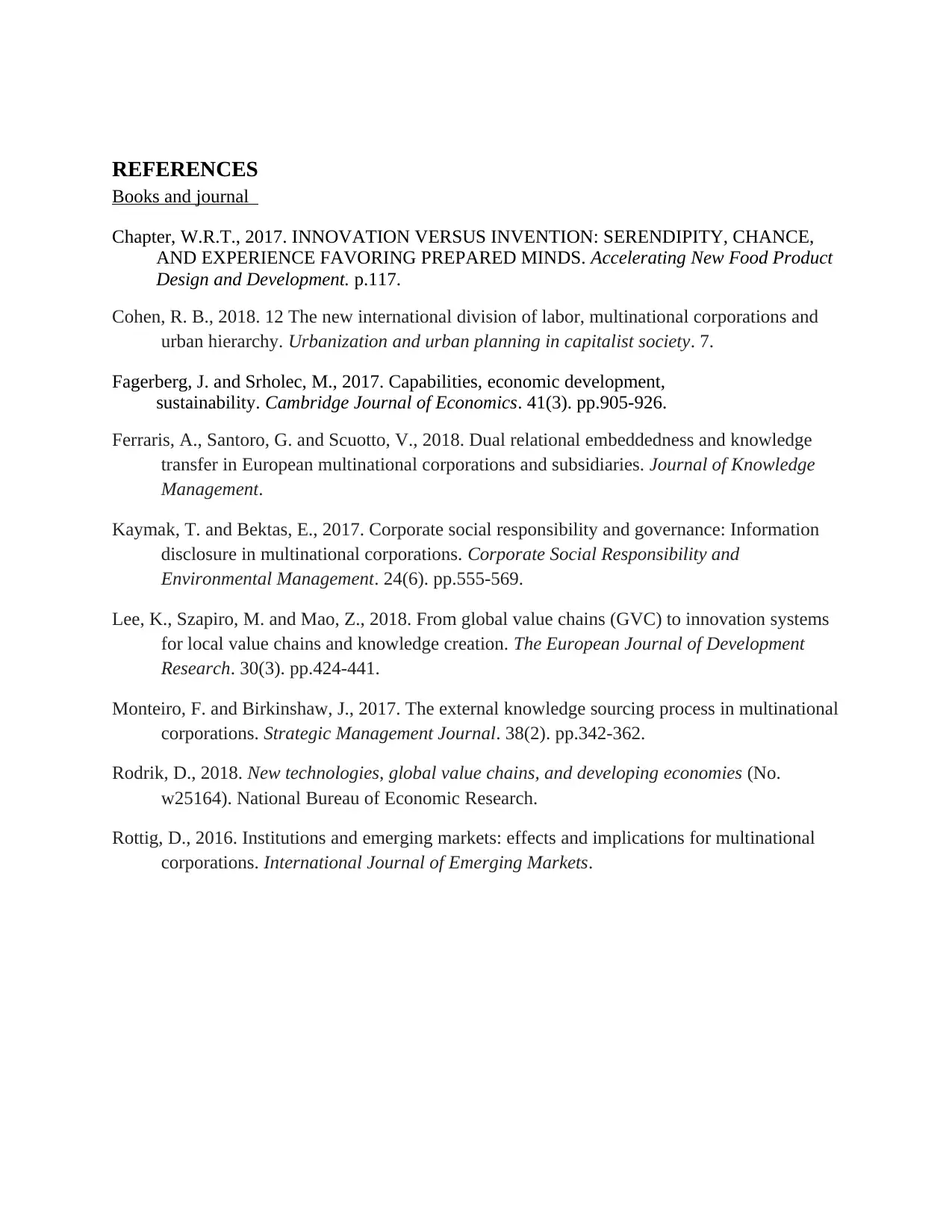
REFERENCES
Books and journal
Chapter, W.R.T., 2017. INNOVATION VERSUS INVENTION: SERENDIPITY, CHANCE,
AND EXPERIENCE FAVORING PREPARED MINDS. Accelerating New Food Product
Design and Development. p.117.
Cohen, R. B., 2018. 12 The new international division of labor, multinational corporations and
urban hierarchy. Urbanization and urban planning in capitalist society. 7.
Fagerberg, J. and Srholec, M., 2017. Capabilities, economic development,
sustainability. Cambridge Journal of Economics. 41(3). pp.905-926.
Ferraris, A., Santoro, G. and Scuotto, V., 2018. Dual relational embeddedness and knowledge
transfer in European multinational corporations and subsidiaries. Journal of Knowledge
Management.
Kaymak, T. and Bektas, E., 2017. Corporate social responsibility and governance: Information
disclosure in multinational corporations. Corporate Social Responsibility and
Environmental Management. 24(6). pp.555-569.
Lee, K., Szapiro, M. and Mao, Z., 2018. From global value chains (GVC) to innovation systems
for local value chains and knowledge creation. The European Journal of Development
Research. 30(3). pp.424-441.
Monteiro, F. and Birkinshaw, J., 2017. The external knowledge sourcing process in multinational
corporations. Strategic Management Journal. 38(2). pp.342-362.
Rodrik, D., 2018. New technologies, global value chains, and developing economies (No.
w25164). National Bureau of Economic Research.
Rottig, D., 2016. Institutions and emerging markets: effects and implications for multinational
corporations. International Journal of Emerging Markets.
Books and journal
Chapter, W.R.T., 2017. INNOVATION VERSUS INVENTION: SERENDIPITY, CHANCE,
AND EXPERIENCE FAVORING PREPARED MINDS. Accelerating New Food Product
Design and Development. p.117.
Cohen, R. B., 2018. 12 The new international division of labor, multinational corporations and
urban hierarchy. Urbanization and urban planning in capitalist society. 7.
Fagerberg, J. and Srholec, M., 2017. Capabilities, economic development,
sustainability. Cambridge Journal of Economics. 41(3). pp.905-926.
Ferraris, A., Santoro, G. and Scuotto, V., 2018. Dual relational embeddedness and knowledge
transfer in European multinational corporations and subsidiaries. Journal of Knowledge
Management.
Kaymak, T. and Bektas, E., 2017. Corporate social responsibility and governance: Information
disclosure in multinational corporations. Corporate Social Responsibility and
Environmental Management. 24(6). pp.555-569.
Lee, K., Szapiro, M. and Mao, Z., 2018. From global value chains (GVC) to innovation systems
for local value chains and knowledge creation. The European Journal of Development
Research. 30(3). pp.424-441.
Monteiro, F. and Birkinshaw, J., 2017. The external knowledge sourcing process in multinational
corporations. Strategic Management Journal. 38(2). pp.342-362.
Rodrik, D., 2018. New technologies, global value chains, and developing economies (No.
w25164). National Bureau of Economic Research.
Rottig, D., 2016. Institutions and emerging markets: effects and implications for multinational
corporations. International Journal of Emerging Markets.
⊘ This is a preview!⊘
Do you want full access?
Subscribe today to unlock all pages.

Trusted by 1+ million students worldwide

1 out of 10
Related Documents
Your All-in-One AI-Powered Toolkit for Academic Success.
+13062052269
info@desklib.com
Available 24*7 on WhatsApp / Email
![[object Object]](/_next/static/media/star-bottom.7253800d.svg)
Unlock your academic potential
Copyright © 2020–2025 A2Z Services. All Rights Reserved. Developed and managed by ZUCOL.




